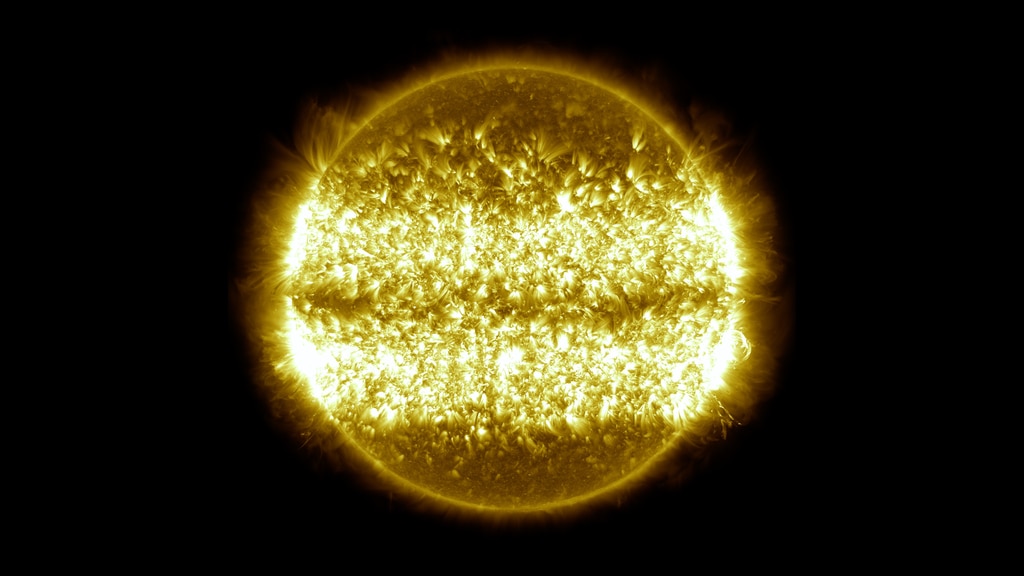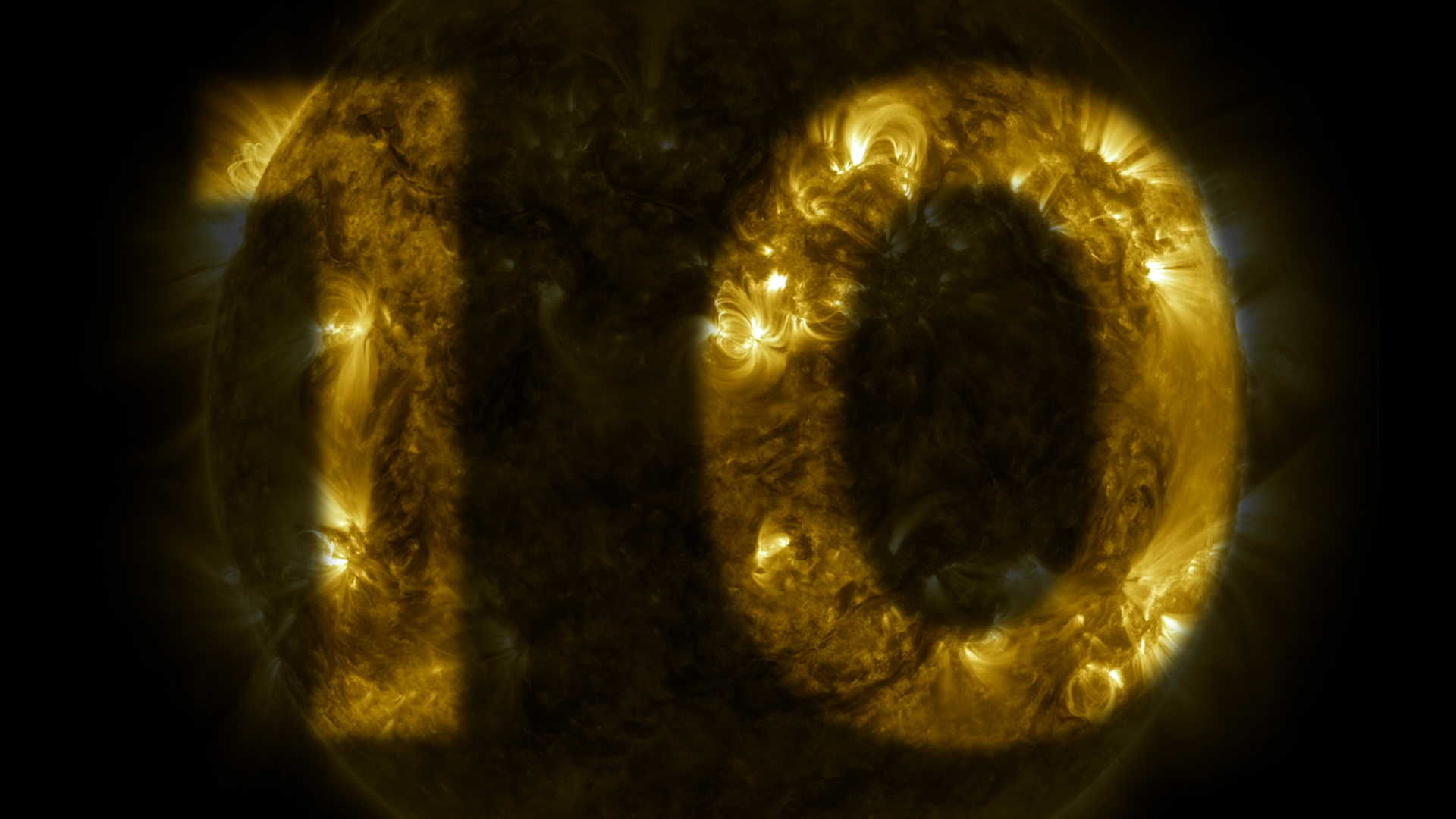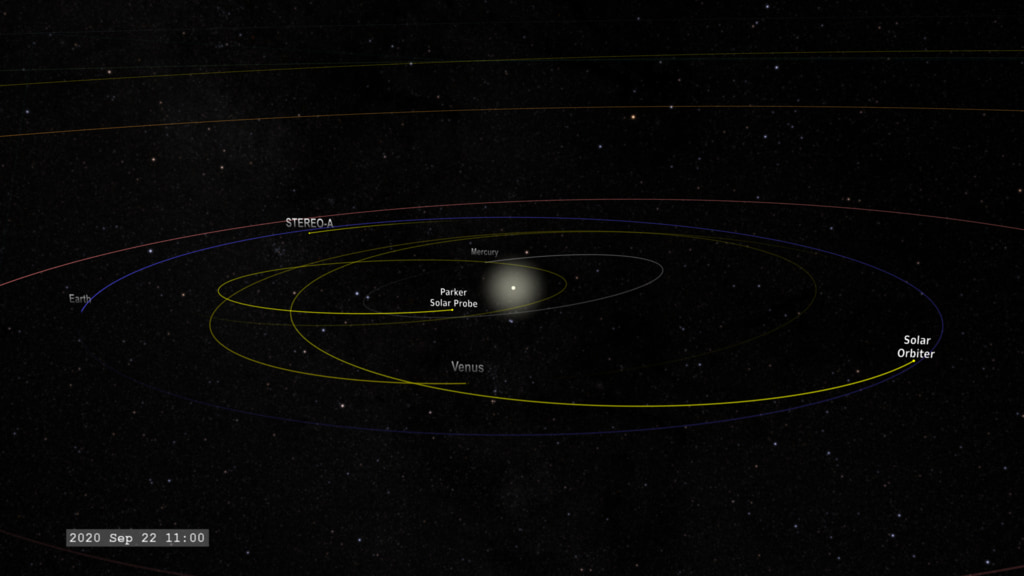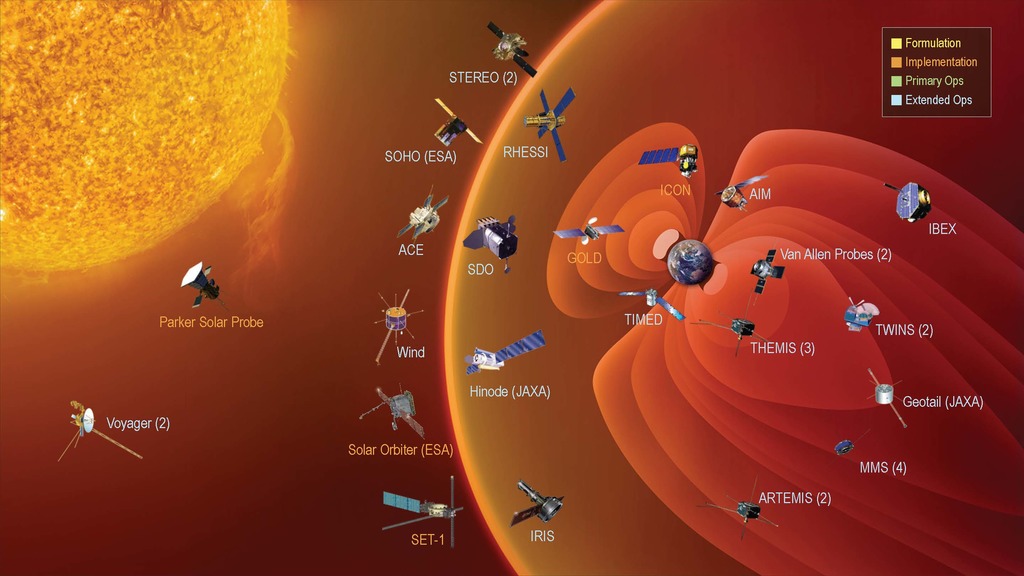The Solar Cycle
Overview
Solar Cycle 25 has begun. The Solar Cycle 25 Prediction Panel announced solar minimum occurred in December 2019, marking the transition into a new solar cycle. In a press event, experts from the panel, NASA, and NOAA discussed the analysis and Solar Cycle 25 prediction, and how the rise to the next solar maximum and subsequent upswing in space weather will impact our lives and technology on Earth.
A new solar cycle comes roughly every 11 years. Over the course of each cycle, the star transitions from relatively calm to active and stormy, and then quiet again; at its peak, the Sun’s magnetic poles flip. Now that the star has passed solar minimum, scientists expect the Sun will grow increasingly active in the months and years to come.
Understanding the Sun’s behavior is an important part of life in our solar system. The Sun’s outbursts—including eruptions known as solar flares and coronal mass ejections—can disturb the satellites and communications signals traveling around Earth, or one day, Artemis astronauts exploring distant worlds. Scientists study the solar cycle so we can better predict solar activity.
Media Events
Solar Cycle 25 Is Here. NASA, NOAA Scientists Explain What This Means
Go to this pageSolar Cycle 25 has begun. The Solar Cycle 25 Prediction Panel announced solar minimum occurred in December 2019, marking the transition into a new solar cycle. In a press event, experts from the panel, NASA, and NOAA discussed the analysis and Solar Cycle 25 prediction, and how the rise to the next solar maximum and subsequent upswing in space weather will impact our lives and technology on Earth.A new solar cycle comes roughly every 11 years. Over the course of each cycle, the star transitions from relatively calm to active and stormy, and then quiet again; at its peak, the Sun’s magnetic poles flip. Now that the star has passed solar minimum, scientists expect the Sun will grow increasingly active in the months and years to come.Understanding the Sun’s behavior is an important part of life in our solar system. The Sun’s outbursts—including eruptions known as solar flares and coronal mass ejections—can disturb the satellites and communications signals traveling around Earth, or one day, Artemis astronauts exploring distant worlds. Scientists study the solar cycle so we can better predict solar activity.Click here for the NOAA press kit.Listen to the media telecon.Participants:• Lisa Upton, Co-chair, Solar Cycle 25 Prediction Panel; Solar Physicist, Space Systems Research Corporation• Doug Biesecker, Solar Physicist, NOAA’s Space Weather Prediction Center; Co-chair, Solar Cycle 25 Prediction Panel• Elsayed Talaat, Director, Office of Projects, Planning and Analysis; NOAA’s Satellite and Information Service • Lika Guhathakurta, Heliophysicist, Heliophysics Division, NASA Headquarters • Jake Bleacher, Chief Exploration Scientist, NASA Human Exploration and Operations Mission Directorate ||
NASA/NOAA Interview Opportunity: Space Weather live shots
Go to this pageClick here for NOAA's Solar Minimum Press Kit with downloadable imagery and b-roll.Cut b-roll for the live shots will be posted Tuesday, Sept 15 by 4:00 p.m. EST || SolarBanner5.jpg (2448x382) [463.6 KB] || SolarBanner5_print.jpg (1024x159) [164.0 KB] || SolarBanner5_searchweb.png (320x180) [93.2 KB] || SolarBanner5_thm.png (80x40) [18.1 KB] ||
Data Visualizations
Coronal Holes at Solar Minimum and Solar Maximum
Go to this pageA sample of solar coronal holes around the time of the maximum of sunspot activity (April 2014). Note the polar regions are devoid of coronal holes but a large hole appears in the southern hemisphere. || CoronalHoleMax_AIA193_00150_print.jpg (1024x1024) [173.1 KB] || CoronalHoleMax_AIA193_00150_searchweb.png (320x180) [89.6 KB] || CoronalHoleMax_AIA193_00150_thm.png (80x40) [7.4 KB] || CoronalHoleMax_AIA193_2048p30.mp4 (2048x2048) [61.7 MB] || CoronalHoleMax_AIA193_2048p30.webm (2048x2048) [2.9 MB] || frames/4096x4096_1x1_30p/CoronalHoleMaximum_193A/AIA193-Time/ (4096x4096) [64.0 KB] || frames/4096x4096_1x1_30p/CoronalHoleMaximum_193A/AIA193-Frames/ (4096x4096) [64.0 KB] || frames/600x100_6x1_30p/CoronalHoleMax_Timestamp/ (600x100) [64.0 KB] ||
The Solar Polar Magnetic Field
Go to this pageFrom our single vantage point of Earth, our view of the Sun is never complete. While the far-side of the Sun eventually rotates into view, coverage of the Sun's polar regions is never satisfactory as perspective effects either completely block our view or create a distorted view. We must often resort to computer modeling of these solar polar regions.This visualization presents the Potential Field Source Surface (PFSS) magnetic field model based on solar observations covering the years 2017-2019. One version also presents the 'hole' in our measurements of the solar polar region. The region oscillates in size over the course of the year due to the changing perspective created by the tilt of Earth's orbital plane with the solar equator. In this region, researchers must resort to approximations to build a more complete view of the solar magnetic field.Why is the solar magnetic field in this region important? Because the combined with the outgoing flow of the solar wind, the magnetic field lines from the polar regions curve up, and then back down to near the Sun's equatorial plane, which is still fairly close to the orbital plane of Earth and other planets in our solar system. This gives the Sun's polar magnetic field a significant influence on the space weather impacting Earth and crewed and uncrewed assets around the solar system. ||
Ten Years of Solar Dynamics Observatory
Go to this pageTen years of SDO AIA 171 angstrom data with day time stamp overlay. Frames are sampled approximately one image every hour. || SDOat10_AIA171_stand.UHD2160.01500_print.jpg (1024x576) [47.4 KB] || SDOat10_AIA171_stand.UHD2160.01500_searchweb.png (320x180) [40.9 KB] || SDOat10_AIA171_stand.UHD2160.01500_thm.png (80x40) [4.0 KB] || SDOat10_AIA171.1080p30.mp4 (1920x1080) [3.9 GB] || SDOat10_AIA171.1080p30.webm (1920x1080) [348.5 MB] || frames/3840x2160_16x9_30p/SDOat10_AIA171.baseimage/ (3840x2160) [8.0 MB] || SDOat10_AIA171.UHD2160_p30.mp4 (3840x2160) [13.0 GB] ||
Solar Energetic Particles
Go to this pageThe Sun goes through phases of strong activity, during which eruptions can occur. Such eruptions can have multiple components, including X rays, coronal mass ejection plasma, and solar energetic particles – bursts or events of fast-moving particles. These events can occur suddenly and have the potential to rapidly change the radiation environment of wide swaths of the inner solar system where they may create hazardous conditions. Not only are such conditions dangerous for humans in space, but the intense ionizing radiation can also affect the interior of spacecraft, including sensitive electronics. Solar energetic particles can reach all regions of near-Earth space, including the lunar surface, with the exception of low-altitude and low-latitude Earth orbit, where the Earth’s magnetic field is strong enough to form a protective barrier. ||
Magnetic Reconnection Throughout the Solar System
Go to this pageMagnetic reconnection at a black hole (fast version) || Blackhole_Sequence_Fast_h264.00288_print.jpg (1024x576) [79.8 KB] || Blackhole_Sequence_Fast_h264.00288_searchweb.png (320x180) [72.4 KB] || Blackhole_Sequence_Fast_h264.00288_thm.png (80x40) [5.0 KB] || Blackhole_Sequence_Fast.mov (3840x2160) [891.0 MB] || Blackhole_Sequence_Fast_h264.mov (3840x2160) [46.2 MB] || Blackhole_Sequence_Fast_h264.webm (3840x2160) [4.6 MB] || frames/3840x2160_16x9_30p/blackhole_fast/ (3840x2160) [32.0 KB] || Blackhole_Sequence_v04_2160p30.mp4 (3840x2160) [29.9 MB] ||
Produced Videos
How To Track The Solar Cycle
Go to this pageA new solar cycle comes roughly every 11 years. Over the course of each cycle, the Sun transitions from relatively calm to active and stormy, and then quiet again; at its peak, the Sun’s magnetic poles flip. Now that the star has passed solar minimum, scientists expect the Sun will grow increasingly active in the months and years to come.Understanding the Sun’s behavior is an important part of life in our solar system. The Sun’s outbursts—including eruptions known as solar flares and coronal mass ejections—can disturb the satellites and communications signals traveling around Earth, or one day, Artemis astronauts exploring distant worlds. Scientists study the solar cycle so we can better predict solar activity. As of 2020, the Sun has begun to shake off the sleep of minimum, which occurred in December 2019, and Solar Cycle 25 is underway. Scientists use several indicators to track solar cycle progress. ||
The Solar Cycle As Seen From Space
Go to this pageVIDEO IN ENGLISH Watch this video on the NASA Goddard YouTube channel.The Sun is stirring from its latest slumber. As sunspots and flares, signs of a new solar cycle, bubble from the Sun’s surface, scientists are anticipating a flurry of solar activity over the next few years. Roughly every 11 years, at the height of this cycle, the Sun’s magnetic poles flip—on Earth, that’d be like the North and South Poles’ swapping places every decade—and the Sun transitions from sluggish to active and stormy. At its quietest, the Sun is at solar minimum; during solar maximum, the Sun blazes with bright flares and solar eruptions. In this video, view the Sun's disk from our space telescopes as it transitions from minimum to maximum in the solar cycle.Music credit: "Observance" by Andrew Michael Britton [PRS], David Stephen Goldsmith [PRS] from Universal Production Music || 13716_SolarCycleFromSpace_YouTube.01410_print.jpg (1024x576) [68.8 KB] || 13716_SolarCycleFromSpace_YouTube.01410_searchweb.png (320x180) [35.9 KB] || 13716_SolarCycleFromSpace_YouTube.01410_web.png (320x180) [35.9 KB] || 13716_SolarCycleFromSpace_YouTube.01410_thm.png (80x40) [3.8 KB] || 13716_SolarCycleFromSpace_Facebook.mp4 (1920x1080) [115.2 MB] || 13716_SolarCycleFromSpace_Prores.mov (1920x1080) [1.3 GB] || 13716_SolarCycleFromSpace_Twitter.mp4 (1920x1080) [21.2 MB] || 13716_SolarCycleFromSpace_YouTube.mp4 (1920x1080) [153.6 MB] || 13716_SolarCycleFromSpace_YouTube.webm (1920x1080) [11.0 MB] || SolarCycleAsSeenFromSpace.en_US.srt [630 bytes] || SolarCycleAsSeenFromSpace.en_US.vtt [641 bytes] ||
A Decade of Sun
Go to this pageThis 10-year time lapse of the Sun at 17.1nm shows the rise and fall of the solar cycle and notable events, like transiting planets and solar eruptions. Music: "Solar Observer" written and produced for this video by Lars Leonhard.Credit: NASA's Goddard Space Flight Center/SDOWatch this video on the NASA Goddard YouTube channel.Complete transcript available. || SDO_Year10_Poster_1080.png (1920x1080) [7.5 MB] || SDO_Year10_Poster_1080.jpg (1920x1080) [519.0 KB] || SDO_Year10_Poster_4k.jpg (3840x2160) [972.4 KB] || SDO_Year10_Poster_4k.png (3840x2160) [27.2 MB] || SDO_10_Year_Sun_1080_15mbps.mp4 (1920x1080) [6.5 GB] || SDO_Year_10_FINAL_720FB.mp4 (1280x720) [7.3 GB] || SDO_10_Year_Sun_1080_15mbps.webm (1920x1080) [482.2 MB] || SDO_10_Year_Sun_ProRes_3840x2160_24.mov (3840x2160) [191.6 GB] || SDO_10_Year_Sun_4k_100mbps.mp4 (3840x2160) [42.9 GB] || SDO_10_Year_Sun_4k_20mbps.mp4 (3840x2160) [8.7 GB] || SDO_10_Year_Sun_SRT_Captions.en_US.srt [2.7 KB] || SDO_10_Year_Sun_SRT_Captions.en_US.vtt [2.8 KB] ||
SDO Celebrates its Tenth Launch Anniversary
Go to this pageCapturing an image in ten different wavelengths of light every 12 seconds, NASA’s Solar Dynamics Observatory — SDO — has provided an unprecedentedly clear picture of how massive explosions on the Sun grow and erupt ever since its launch on Feb. 11, 2010. The imagery is also captivating, allowing one to watch the constant ballet of solar material through the Sun's atmosphere, the corona. This year marks the tenth anniversary of SDO's launch and the start of its decade watching the Sun.Music: "Encompass" from Universal Production MusicWatch this video on the NASA Goddard YouTube channel.Complete transcript available. || PROMO_FINAL.00_01_04_08.Still001.jpg (1920x1080) [489.9 KB] || PROMO_FINAL.00_01_04_08.Still001_searchweb.png (320x180) [80.6 KB] || PROMO_FINAL.00_01_04_08.Still001_thm.png (80x40) [6.0 KB] || SDO_10th_Promo_ProRes_1920x1080_2997.mov (1920x1080) [981.6 MB] || SDO_10th_Promo_Best_1080.mp4 (1920x1080) [363.3 MB] || SDO_10th_Promo_Good_1080.mp4 (1920x1080) [141.7 MB] || SDO_10th_Promo_Best_1080.webm (1920x1080) [10.2 MB] || SDO_10th_Promo_SRT_Captions.en_US.srt [820 bytes] || SDO_10th_Promo_SRT_Captions.en_US.vtt [833 bytes] ||
NASA Missions
Heliophysics Sentinels 2020
Go to this pageThere have been few changes since the 2018 Heliophysics Fleet. Van Allen Probes and SORCE have been decommissioned, while Solar Orbiter, ICON and SET have been added. As of spring 2020, here's a tour of the NASA Heliophysics fleet from the near-Earth satellites out to the Voyagers beyond the heliopause.Excepting the Voyager missions, the satellite orbits are color coded for their observing program:Magenta: TIM (Thermosphere, Ionosphere, Mesosphere) observationsYellow: solar observations and imageryCyan: Geospace and magnetosphereViolet: Heliospheric observations ||
NASA's Heliophysics Fleet
Go to this pageHeliophysics encompasses science that improves our understanding of fundamental physical processes throughout the solar system, and enables us to understand how the Sun, as the major driver of the energy throughout the solar system, impacts our technological society. The scope of heliophysics is vast, spanning from the Sun’s interior to Earth’s upper atmosphere, throughout interplanetary space, to the edges of the heliosphere, where the solar wind interacts with the local interstellar medium. Heliophysics incorporates studies of the interconnected elements in a single system that produces dynamic space weather and that evolves in response to solar, planetary, and interstellar conditions. ||
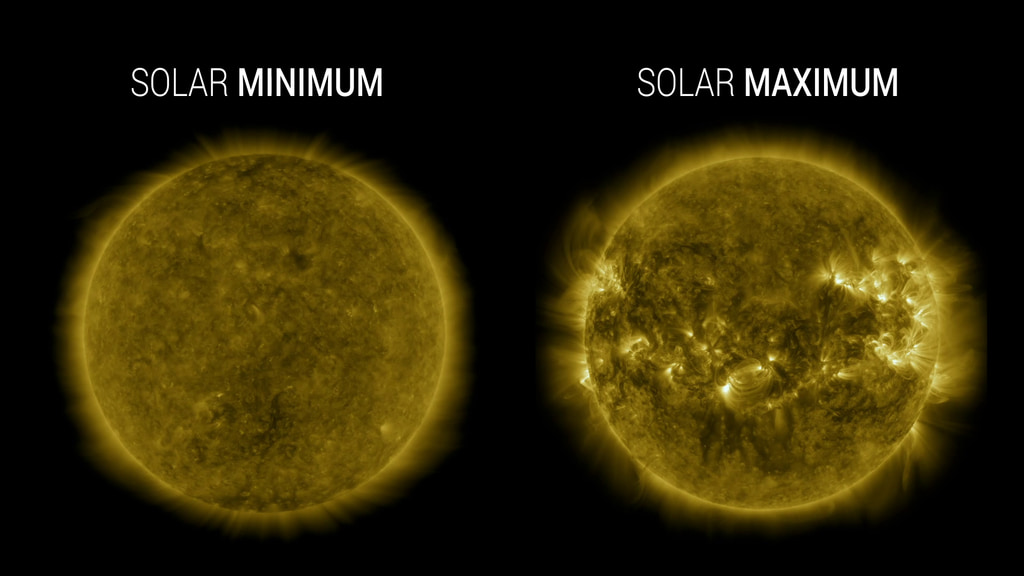

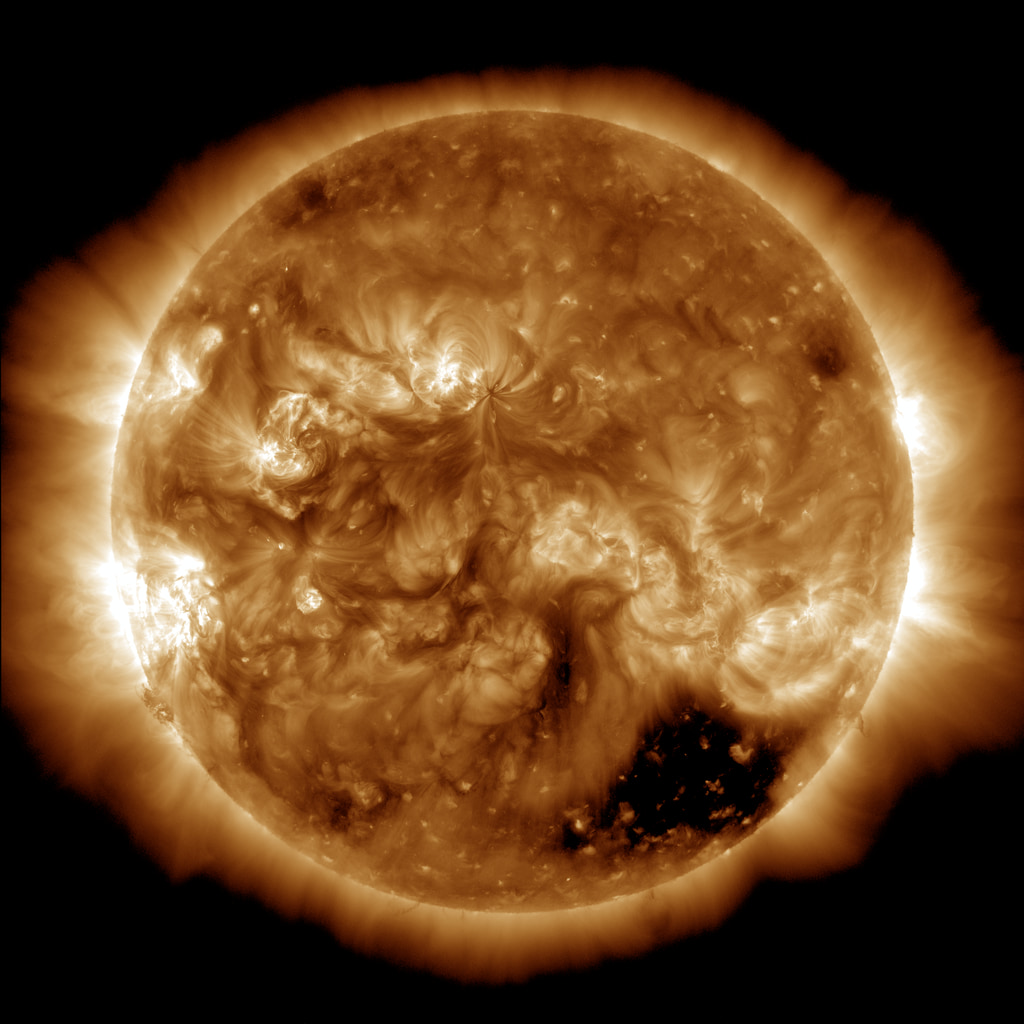
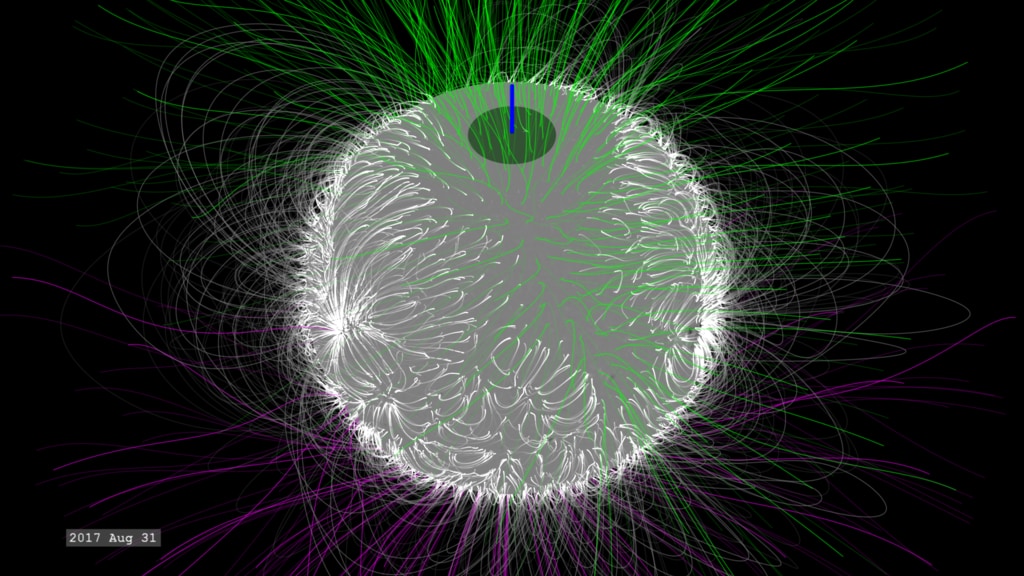
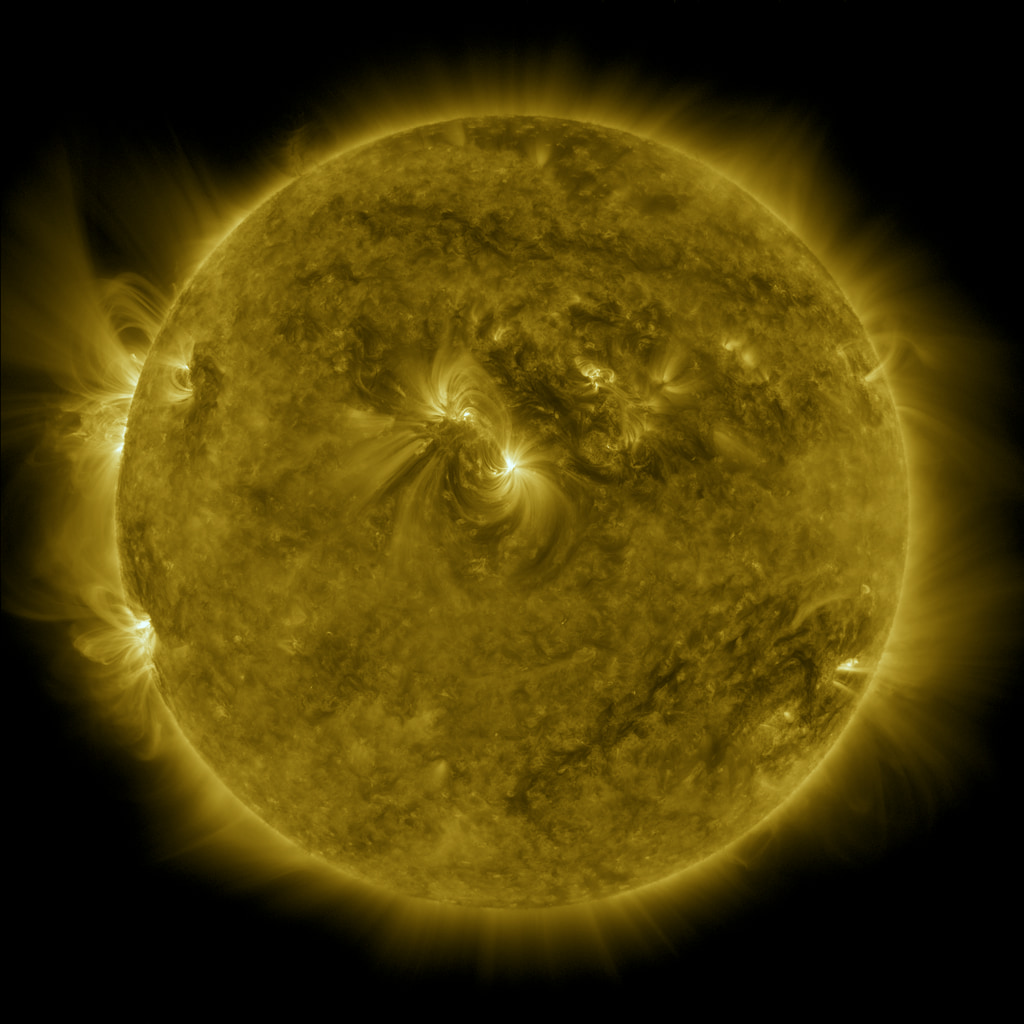
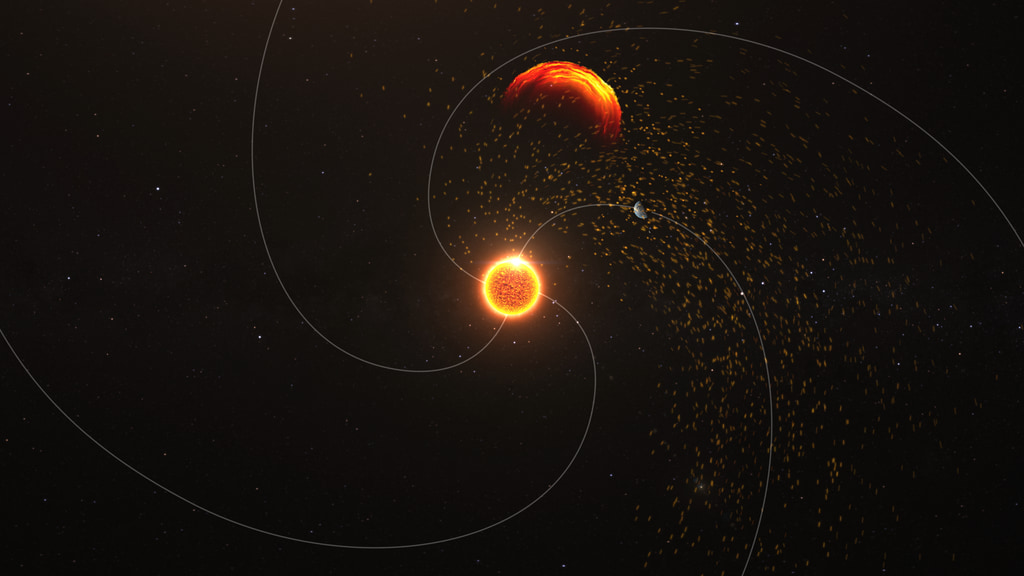
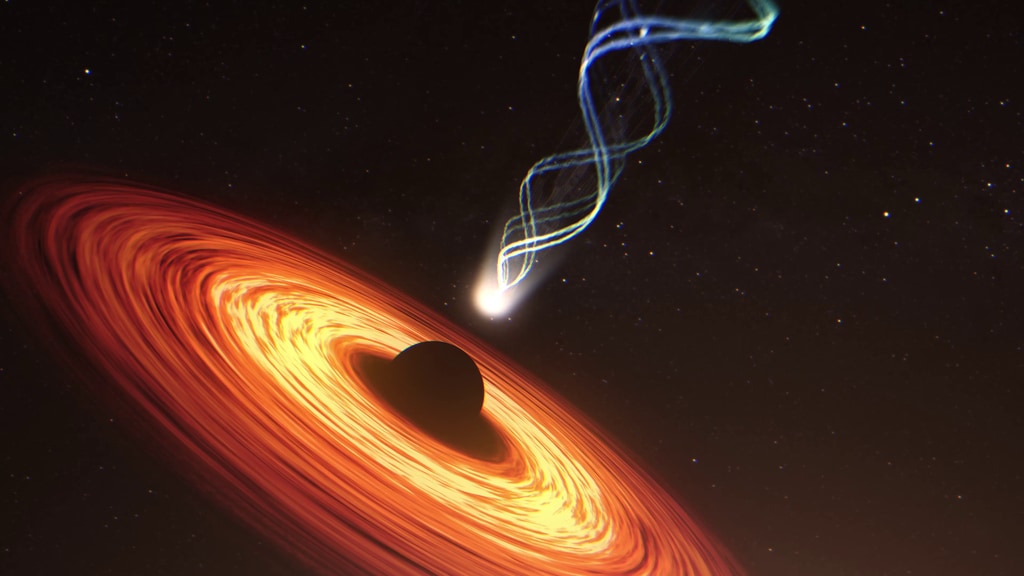
![Watch this video on the NASA Goddard YouTube channel.Complete transcript available.Music credits: “Infinite” by Joseph Pincus [ASCAP]; “Reflective Sensations”, “Ideas For Tomorrow”, “Think Tank” by Laurent Dury [SACEM]; “Wonderful Orbit” by Tom Furse Fairfax Cowan [PRS]](/vis/a010000/a013700/a013715/13715_TrackSolarCycle_YouTube.00284_print.jpg)
![VIDEO IN ENGLISH Watch this video on the NASA Goddard YouTube channel.The Sun is stirring from its latest slumber. As sunspots and flares, signs of a new solar cycle, bubble from the Sun’s surface, scientists are anticipating a flurry of solar activity over the next few years. Roughly every 11 years, at the height of this cycle, the Sun’s magnetic poles flip—on Earth, that’d be like the North and South Poles’ swapping places every decade—and the Sun transitions from sluggish to active and stormy. At its quietest, the Sun is at solar minimum; during solar maximum, the Sun blazes with bright flares and solar eruptions. In this video, view the Sun's disk from our space telescopes as it transitions from minimum to maximum in the solar cycle.Music credit: "Observance" by Andrew Michael Britton [PRS], David Stephen Goldsmith [PRS] from Universal Production Music](/vis/a010000/a013700/a013716/13716_SolarCycleFromSpace_YouTube.01410_print.jpg)
